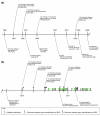Unlocking Mendelian disease using exome sequencing
- PMID: 21920049
- PMCID: PMC3308044
- DOI: 10.1186/gb-2011-12-9-228
Unlocking Mendelian disease using exome sequencing
Abstract
Exome sequencing is revolutionizing Mendelian disease gene identification. This results in improved clinical diagnosis, more accurate genotype-phenotype correlations and new insights into the role of rare genomic variation in disease.
Figures


References
-
- Oti M, Brunner HG. The modular nature of genetic diseases. Clin Genet. 2007;71:1–11. - PubMed
-
- Peltonen L, Perola M, Naukkarinen J, Palotie A. Lessons from studying monogenic disease for common disease. Hum Mol Genet. 2006;15 Spec No 1:R67–R74. - PubMed
-
- Kurotaki N, Imaizumi K, Harada N, Masuno M, Kondoh T, Nagai T, Ohashi H, Naritomi K, Tsukahara M, Makita Y, Sugimoto T, Sonoda T, Hasegawa T, Chinen Y, Tomita Ha HA, Kinoshita A, Mizuguchi T, Yoshiura Ki K, Ohta T, Kishino T, Fukushima Y, Niikawa N, Matsumoto N. Haploinsufficiency of NSD1 causes Sotos syndrome. Nat Genet. 2002;30:365–366. doi: 10.1038/ng863. - DOI - PubMed
Publication types
MeSH terms
LinkOut - more resources
Full Text Sources
Other Literature Sources
Medical

